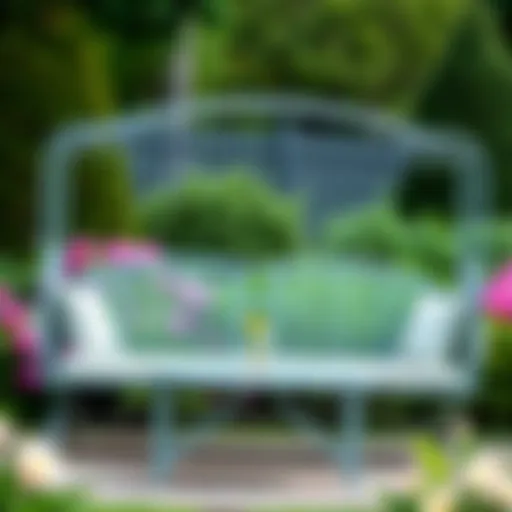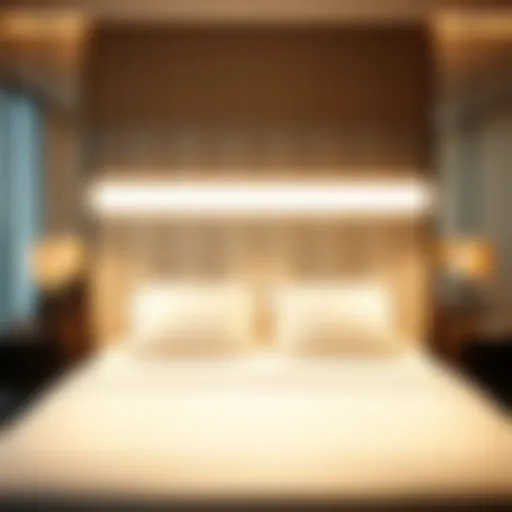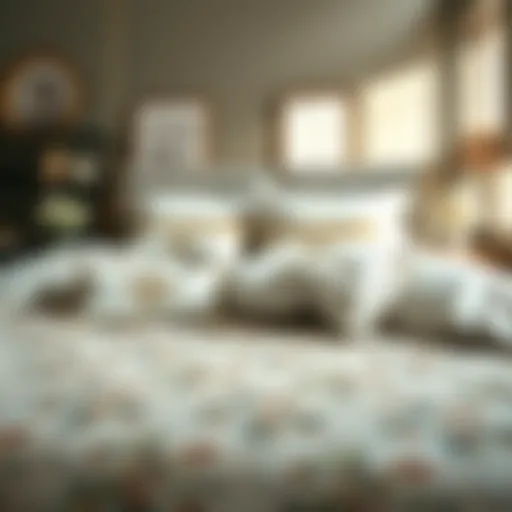Harmonizing Living Spaces with Sofas and Ottomans
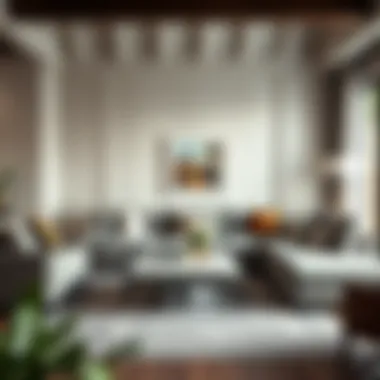
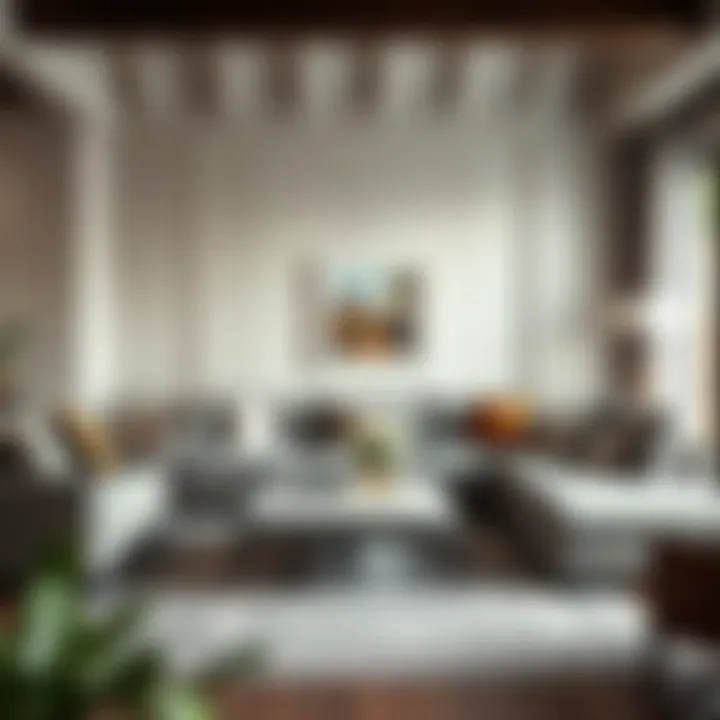
Intro
Creating a harmonious living space is no small feat, especially when it comes to choosing the right furniture. Among the most vital combinations in that space is the pairing of a sofa and an ottoman. These pieces not only serve practical purposes but also act as focal points that can define your living area’s aesthetic. In this article, we’ll dive deep into the intricate relationship between sofas and ottomans, how they complement each other, and how to select and care for them.
This exploration isn’t just about style; it cuts to the core of comfort and utility in your home. Whether you’re a homeowner, renter, or an interior designer, understanding the nuances that surround these items can lead to a more cohesive and inviting environment.
Furniture Trends
Current Market Trends
The furniture landscape is always shifting, influenced by cultural movements, sustainability practices, and technological advancements. Right now, the trend leans heavily towards creating adaptable spaces. Sofas and ottomans are being designed not just for comfort, but also for versatility. For instance, modular sofas that can be easily reconfigured are gaining traction in urban spaces where every inch counts.
Moreover, the use of eco-friendly materials such as reclaimed wood and organic fabrics is becoming more prevalent. As consumers become more environmentally conscious, there's a push for furniture that harmonizes with nature both in aesthetics and sustainability.
Popular Styles and Designs
When considering styles, modern minimalism reigns supreme. Think clean lines, neutral color palettes, and multifunctional ottomans that serve as both footrests and storage solutions. However, mid-century modern designs are not far behind, characterized by bold colors and distinctive shapes.
Here are some of the crowd favorites:
- Scandinavian Design: Characterized by simplicity and functionality, often featuring light wood and soft, muted colors.
- Industrial Style: Incorporating raw materials and a rugged aesthetic, perfect for lofts and urban settings.
- Bohemian Flair: Infuses creativity with mixed patterns and vibrant colors, ideal for those looking to showcase their personality.
It's essential to match these styles not only with your existing decor but also with the practical needs of your space.
DIY Projects
Step-by-Step Guides
If you’re feeling crafty, consider customizing your ottoman. Here’s a straightforward guide to making a simple yet stylish upholstered ottoman:
- Materials Needed:
- Instructions:
- Finish Up:
- Plywood (for the base)
- Foam padding (to provide comfort)
- Fabric of your choice
- Staple gun and staples
- Legs or casters (optional)
- Cut plywood to your desired size.
- Attach foam padding on the top using adhesive.
- Pull the fabric over the foam, folding it beneath the plywood, and secure it with a staple gun.
- If you want height or mobility, attach legs or caster wheels.
- Make sure all edges are neatly stapled and trimmed.
This project not only enhances your space but allows personal touches. Choosing vibrant fabric can completely change the game.
Budget-Friendly Ideas
If crafting isn't your forte, you can still find lovely ways to incorporate sofas and ottomans within a budget:
- Thrift Store Finds: Many second-hand stores offer hidden treasures. A quick reupholstery can breathe new life into a vintage piece.
- Ottomans from Functional Items: Consider repurposing an old coffee table covered with a stylish throw to serve as an ottoman.
- Sofa Slipcovers: They can change the whole look of your sofa without breaking the bank. Slipcovers that are machine washable and easy to change will keep your piece fresh.
"A well-chosen sofa and ottoman can transform an ordinary living space into something extraordinary. It's about more than comfort; it’s an expression of who you are."
Decorating with intention not only creates beauty but also a sense of belonging in your space.
By understanding current trends and adopting some DIY creativity, you can curate an environment that not only feels good but reflects your unique style.
For more comprehensive guides on home design, check resources like Houzz, or The Spruce. Experts often share tips that bridge the gap between professional interior design and amateur home decorating.
The Historical Context of Sofas and Ottomans
Understanding the historical context of sofas and ottomans offers crucial insights into their significance in modern interior design. Not merely furniture pieces, these items embody aesthetics, comfort, and practicality that have evolved over centuries. From their humble beginnings to their current status as essential elements of living space, the journey of sofas and ottomans reflects changes in societal values, design trends, and human interaction with space.


Origin of the Sofa
Sofas trace their origins back to ancient civilizations; however, their more recognizable form emerged during the Renaissance in Europe. The term "sofa" itself is derived from the Arabic word "suffah," which means a bench covered with cushions or blankets. Early sofas were primarily designed for lounging, often adorned with intricate designs, demonstrating a blend of utility and artistry.
In the 18th century, sofas became a staple in aristocratic homes, characterized by elegant upholstery and elaborate woodwork. During the Victorian era, their popularity soared, and they were often seen as a reflection of wealth and status. This era also saw the introduction of different styles—chaise lounges, settees, and loveseats—all catering to various functions and tastes. As lifestyles evolved, so did the sofa's form, transitioning from a mere status symbol to a central piece of comfort in homes.
The Ottoman's Journey
Ottomans are a different kind of story. Their name is tied to the Ottoman Empire, where they first appeared as padded footrests or low seating options. Unlike the sofa, the ottoman served multiple purposes—primarily functioning as a footrest but also designed to provide extra seating or storage.
Over the years, the ottoman underwent a transformation, adapting to different styles and needs. By the late 19th century, they became more prominent in Western homes, often used as decorative accents. This adaptability has allowed ottomans to be made in various shapes and sizes, serving diverse functionalities—from upholstered cubes to elaborate storage pieces.
The evolution of both the sofa and ottoman illustrates how these items respond to not just aesthetic preferences, but also shifts in lifestyle and the way people inhabit their spaces. Today, they continue to represent more than mere comfort; they embody a harmonious blend of traditional craftsmanship and contemporary design principles.
"The design evolution of sofas and ottomans showcases how human creativity intertwines with practicality in living spaces."
Each piece must be thoughtfully considered in relation to one's environment, making these items integral to achieving harmony in living spaces. By understanding their historical layers, designers and homeowners alike can appreciate how to make informed choices about integrating these elements into their homes.
Design Principles for Sofas and Ottomans
When diving into the intricate world of interior design, one cannot overlook the design principles that govern the relationship between sofas and ottomans. These principles serve as the backbone of any harmonious living space, ensuring that furniture pieces don't just exist in the same area, but work in tandem to create a cohesive atmosphere. Understanding these principles can elevate any designer’s or homeowner’s approach to furnishing spaces, making each room not only stylish but functional.
Importance of Scale and Proportion
Scale and proportion are the cornerstones in the conversation about furniture arrangement. A sofa that fits neatly into a room's dimensions can transform a cramped space into a lively environment. When selecting sofas and ottomans, it’s crucial to consider how their sizes interact with the surrounding furniture and the overall layout.
For instance, consider a room with a small layout. A bulky sectional sofa may dominate the space, making it feel cluttered. On the flip side, an oversized ottoman can throw off the balance, interrupting the flow. Ideally, one should aim for furniture that complements the dimensions of the room.
- Measure your space before you shop. This gives you a clear idea of what fits.
- A good rule of thumb is that there should be at least 30 inches of walking space around furniture to ensure ease of movement.
- Contrast also matters; a low-slung sofa can look stunning next to a tall ottoman, creating a visual balance that draws the eye.
Always keep in mind that scale and proportion are not just technical terms; they are emotional cues that can make spaces more inviting and comfortable.
Color Coordination Techniques
The color scheme of your living area significantly defines its personality and vibe. Sofas and ottomans, often two of the largest pieces in a room, offer a fantastic platform for experimenting with color coordination. The right hues can enhance mood, create visual interest, and even affect spatial perception.
Creating cohesion in color doesn’t mean everything has to match perfectly. Here are some pointers:
- Create a palette: Choose a base color for your sofa; softer shades tend to make a room feel larger, while darker shades add coziness.
- Accent with ottomans: Use ottomans to introduce bolder tones or patterns, providing a pop of color that draws attention without overwhelming the space.
- Consider the surroundings: Look closely at wall colors, rugs, and other key elements. Your sofa and ottoman should either complement or skillfully contrast these elements.
Utilizing color coordination techniques not only ties a room together but can also express personal style in a striking yet harmonious manner.
Materials and Textures
In the dialogue surrounding sofas and ottomans, the choice of materials and textures plays a pivotal role. The tactile experiences that different finishes provide can drastically influence the comfort and aesthetics of a room.
Consider the following when selecting materials:
- Fabric choices: Leather gives a sophisticated feel, while cotton or linen adds a more casual vibe. Think about how each material works with not just the sofa or ottoman but the entirety of the living space.
- Durability: Especially for households with pets or children, selecting materials that withstand wear and tear is paramount. Fabrics like microfibers can offer resilience without sacrificing comfort or style.
- Mixing textures: Combine different textures within the same color family. For example, a velvet sofa paired with a chunky knit ottoman can create a visual and tactile intrigue.
The interplay of materials and textures can truly transform a living space, enhancing both comfort and visual appeal while also ensuring that each piece of furniture holds its ground against the test of time.
"Choosing the right mix of scale, color, and materials is not just about aesthetics; it’s about creating a space that speaks to your soul."
By focusing on these foundational design principles, homeowners and designers alike can craft a living area that is not just visually appealing but also pleasantly functional. This careful orchestration of elements is integral to mastering the art of living space harmony.
Choosing the Right Sofa
Choosing the right sofa is crucial for any living space. It serves as the centerpiece of the room, influencing both aesthetics and comfort. A well-chosen sofa not only complements your design but also enhances functionality within the space. You want something that fits snugly without overcrowding, offering a welcoming feel to guests while echoing your personal style.

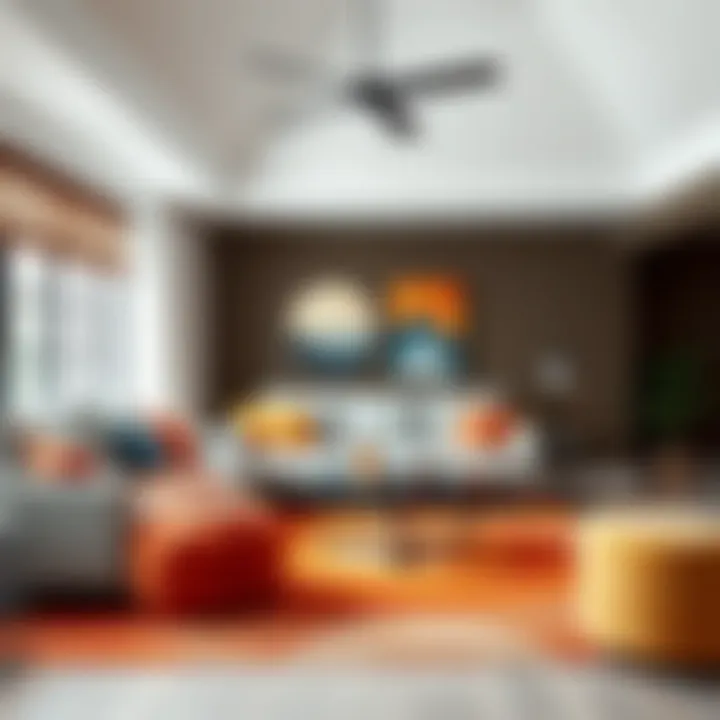
A sofa should reflect your lifestyle. If you have a busy family life, you might prioritize durability and ease of cleaning. For those who frequently entertain, seating capacity and comfort become vital. Think about your day-to-day activities in the living area. A thoughtfully selected sofa can be the difference between a cozy gathering spot and a disjointed space.
Assessing Space Requirements
Before buying a sofa, you'll need to take a close look at your space. Consider both the dimensions of the room and the layout. Measure the area where the sofa will go. Don’t just focus on length and depth; think also about height. Low-profile sofas can create an airy feel in smaller rooms. In contrast, taller backs might feel oppressive in a cramped environment.
When charting out your space, visualize how the sofa interacts with other furniture pieces and pathways. Here are some key points to consider:
- Room Dimensions: Take precise measurements so you can visualize the scale.
- Flow of Movement: Aim for a layout that allows smooth transitions and foot traffic.
- Placement Options: Consider an angled placement if the room shape allows for it; this can create a more dynamic look.
"The best sofa isn’t just about looks; it harmonizes with its surroundings, enhancing the entire environment."
Functionality and Comfort
Functionality goes hand-in-hand with comfort when selecting a sofa. A sofa might look fabulous, but if it isn’t cozy or suitable for your needs, it’s not doing its job. Consider how you use your living room. Do you watch movies, host game nights, or simply unwind? A sofa with a good depth and a supportive back ensures that you can sink right in without feeling cramped.
Also, think about convertible options. A sleeper sofa or one that doubles as a chaise lounge can offer added flexibility for guests or lounging. Furthermore, test out the cushions. A mix of firmness and softness can cater to varying preferences—whether you want to sink in after a long day or need something supportive for reading.
Style Compatibility
A sofa’s style should echo the overall design language of your living space. It acts as a bridge between various design elements, so it’s essential to find one that effortlessly fits in. Think about colors and textures that harmonize with your existing decor. If your room is modern, you might lean towards a sleek sectional in a bold color. Conversely, for a more traditional setting, a classic tufted sofa in an earth tone might be ideal.
Here are a few things to consider:
- Color Scheme: Choose a color that complements your walls and accessories. Neutrals allow for easy swapping of throws and pillows.
- Design Style: From contemporary and rustic to mid-century modern, ensure the sofa aligns with your desired aesthetic.
- Fabric Choice: The material should not just be about looks but practicality. Some fabrics resist stains better than others, and texture can add depth to your space.
In summary, choosing the right sofa isn’t merely a task—it’s an art form. By pondering over space, functionality, and style, you create a living environment that’s not just functional but also aesthetically pleasing.
Selecting the Ideal Ottoman
Choosing the right ottoman is more than just a matter of aesthetics; it’s about finding the piece that best complements your sofa and overall living space. Ottomans can serve a myriad of purposes—from practical storage solutions to versatile footrests. They play a pivotal role in achieving harmony within your interior, providing functionality without sacrificing style. Understanding the considerations involved in selecting the ideal ottoman will allow homeowners, renters, and designers alike to make informed choices that elevate their spaces.
Purpose: Storage vs. Footrest
When it comes to ottomans, their primary function can often dictate the type you decide to invest in. An ottoman can be purely decorative, allowing one to rest their feet and elevate comfort while lounging on the sofa. However, a storage ottoman serves a dual purpose that can particularly benefit smaller spaces. Imagine a chic leather ottoman that not only looks good but also stores remote controls, board games, or magazines. This multifunctional aspect is especially ideal for apartments or living rooms without excess storage options. When considering your lifestyle and space needs, weigh the balance of style with practicality in order to choose a piece that aligns with your vision.
"The right ottoman is like a chameleon—you want it to blend seamlessly with your decor while providing the utility you need."
Shape and Size Variations
Shapes and sizes can dramatically affect how an ottoman integrates into your living space. Round ottomans soften angular furniture layouts, while rectangular ottomans are often more versatile and can fit along the edge of a sofa. If you have a sectional sofa, a large rectangular ottoman can serve as a cohesive anchor point. Alternatively, small, round poufs can be used as casual seating or side tables. When selecting size, consider the scale of your sofa and the proportions of your space. An oversized ottoman may overwhelm a small room, while a tiny one can get lost in a larger area. Pay attention to height as well; the ottoman should harmonize with the height of your seating for an inviting feel.
Integrating Ottomans into Existing Decor
The key to making an ottoman feel right at home in your living space lies in how well it blends with your current decor. Start by looking at color palettes and patterns already present in the room. If your sofa is a bold navy, a neutral or complementary-colored ottoman can serve as a balancing act. For those looking to make a statement, consider a patterned or brightly colored piece that acts as an eye-catching accessory.
Textures also play a critical role in integration. If your space is filled with smooth surfaces, a textured ottoman—such as one covered in velvet or boucle—adds a layer of interest. Additionally, don’t overlook how the ottoman interacts with other furniture. It should seamlessly complement your existing pieces, enhancing the overall aesthetic without tasting overly clashed. A well-placed ottoman can pull a room together like the cherry on top of a sundae.
Functional Aspects of Sofas and Ottomans
The relationship between sofas and ottomans extends beyond aesthetics; it encapsulates a myriad of functional aspects pivotal to both comfort and the overall design of living spaces. For homeowners, renters, designers, and DIY enthusiasts, understanding how these pieces of furniture can enhance the utility of a room is essential. By delving into the functional dimensions, we can unravel the doors they open, creating harmonious environments while providing practical solutions to everyday challenges.
Space Optimization Strategies
Optimizing space is a crucial consideration in any living area. Sofas and ottomans can play a significant role in this regard. When choosing furniture, the goal should be to ensure that every piece serves multiple purposes, allowing for a seamless flow in smaller spaces.
Here are some strategies to keep in mind:
- Choose compact designs: Opt for sofas that do not overpower the room. Sectionals can be particularly useful for maximizing seating without congesting an area.
- Positioning: Arranging furniture around a focal point, like a coffee table or television, can create a cozy atmosphere without making the space feel cramped.
- Leveraging ottomans: An ottoman can serve multiple functions. Whether it's a footrest or a coffee table, consider how its placement can enhance utility while allowing room to navigate.
- Multifunctional options: There are ottomans on the market with built-in storage, perfect for stashing away blankets or books. Using these items enables you to reclaim visual space.
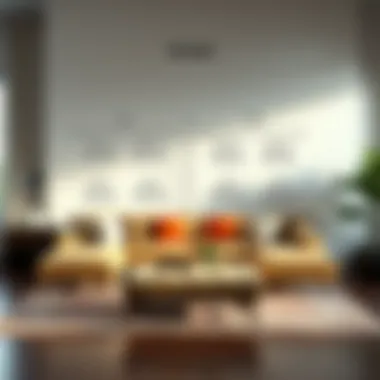

Implementing these strategies means an intentional design setup that can promote fluidity and prevent clutter in your living area.
Dual-Purpose Furniture
The emergence of dual-purpose furniture aligns perfectly with modern lifestyles. With multifunctionality in demand, sofas and ottomans have evolved to serve not just as mere seating elements but also as essential contributors to versatile living spaces.
Consider the following features:
- Sofas that convert: Sofas that convert to beds offer the perfect solution for accommodating guests without needing a dedicated spare room. This transformation capability is particularly beneficial for urban dwellers.
- Ottomans as tables: Ottomans can easily be utilized as coffee tables, supporting trays for beverages or snacks. This functionality maintains a relaxed living atmosphere while ensuring comfort.
- Integrated technology: Some modern sofas now feature integrated charging ports and Bluetooth connectivity, perfectly suited for a tech-savvy audience.
As these dual-purpose pieces seamlessly integrate into living space, they highlight the importance of investing in furniture that adapts to evolving needs, enhancing both the practicality and aesthetic of a home.
"In a world where space is often at a premium, optimizing every inch becomes not just a goal, but a necessity."
Ultimately, focusing on the functional aspects of sofas and ottomans ensures each piece contributes effectively to the living space while fulfilling the fundamental requirements of comfort and usability. Understanding these dimensions allows for informed decisions, leading to a well-coordinated living environment.
Trends in Sofa and Ottoman Design
As we navigate through the ever-evolving landscape of interior design, it becomes clear that sofas and ottomans are much more than mere furniture; they are pivotal elements that can transform the very essence of a living space. The trends in sofa and ottoman design reflect broader societal movements, technological advancements, and aesthetic preferences. This section examines current trends that emphasize the significance of selecting pieces that resonate with individual style while promoting functionality and comfort.
Understanding these trends is crucial for homeowners, renters, designers, and anyone looking to enhance their living areas. The right combination of sofas and ottomans can elevate a room's aesthetic while ensuring comfort and practicality, striking a harmony that is increasingly sought after in modern living.
Contemporary Styles
In today's interior design scene, contemporary styles often lean toward minimalism, with clean lines and understated elegance taking center stage. This trend manifests in various sofa and ottoman designs, ranging from straight-edged sectionals to plush, oversized ottomans that invite relaxation. Homeowners are increasingly favoring bold colors and patterns, which serve as statement pieces within more neutral settings.
Some popular contemporary styles include:
- Mid-Century Modern: Characterized by sleek lines, vibrant colors, and wood accents. Sofas in this style often feature tapered legs, which enhance an airy feel.
- Scandinavian: Emphasizes functionality and simplicity, featuring light woods and soft fabric, promoting coziness without sacrificing style.
- Industrial: Combines raw materials, like metal and leather, often used together for a sophisticated yet rugged look.
The blend of these styles opens room for personal expression while ensuring that the functionality matches the aesthetic. Sofas and ottomans are now seen as essential pieces that allow for versatility, serving multiple purposes in smaller spaces without compromising on design.
Sustainable Choices
With increasing awareness of environmental issues, sustainable choices in furniture design have gained significant traction. Consumers are now more conscious about the materials used in their sofas and ottomans, leading to a rise in eco-friendly options that do not compromise on style. Sustainable design is not just a passing fad; it's a fundamental shift towards more responsible consumption.
When selecting sustainable sofas and ottomans, consider the following:
- Materials: Look for pieces made from reclaimed wood, organic cotton, or recycled materials. These options help reduce waste and promote sustainability.
- Local Manufacturers: Supporting local artisans and manufacturers can also minimize carbon footprints associated with transportation.
- Longevity: Invest in pieces that are built to last. Timeless designs in durable materials can help mitigate the cycle of fast fashion in furniture.
"Investing in sustainable furniture is investing in our planet's future."
Choosing sustainable sofas and ottomans doesn’t mean sacrificing style; rather, it invites an opportunity to merge ethics with aesthetics, providing individuals with the satisfaction of making environmentally sound choices in their homes. As we look ahead, it's clear that the trends influencing sofa and ottoman design are shaped not only by personal taste and convenience but also by a growing commitment to the environment.
Maintenance and Care Tips
Maintaining the appearance and functionality of your sofa and ottoman is crucial for ensuring they serve you well over the years. These pieces of furniture wear out with time, facing challenges from daily use, children, pets, and even the occasional spilled drink. Beyond just aesthetics, regular care extends their lifespan, making your investment worthwhile. The importance of maintaining and caring for them cannot be understated, as it preserves their beauty and overall integrity.
Cleaning Fabrics and Materials
Cleaning your sofa and ottoman is not an arduous task, though some might think it is. Different fabrics react differently to cleaning methods, so it's essential to know a little about the material before diving in.
- Fabric Care Labels: Check for those labels hidden in the crevices. They often provide insight into the best cleaning methods. Common codes include:
- Vacuum Regularly: Dust and crumbs can wear down materials over time. A quick once-over with your vacuum is often enough to keep dirt at bay. Consider a vacuum with a brush attachment to really get into those nooks.
- Stain Removal: It’s always a good idea to tackle stains promptly. For water stains, a mixture of mild dish soap and water usually does the trick. For tougher stains, a professional upholstery cleaner may be required, but try a little spot test first on an inconspicuous area to avoid discoloration.
- W: Water-based cleaner.
- S: Solvent-based cleaner.
- WS: Water or solvent-based cleaner.
- X: Professional cleaning only.
Dealing with Wear and Tear
Wear and tear is inevitable, yet there are ways to manage and even prolong the life of your beloved furniture. The key is to handle these issues before they escalate into larger problems.
- Rotate Cushions: If your sofa has removable cushions, rotating them regularly can prevent uneven wear. This simple act ensures that one side isn’t taking all the brunt of daily use.
- Address Loose Threads: Don’t just ignore that tiny thread hanging off. It can become a loop that pulls at the fabric and leads to bigger issues. Snip it carefully with scissors, but avoid pulling on it, as that could exacerbate the problem.
- Consider Slipcovers: If your sofa sees a lot of action, a slipcover can be a wise investment. It's much easier to wash a slipcover than to clean the entire sofa, plus it allows for quick style changes.
- Protect with Coasters: Always place coasters on your ottoman when serving drinks. It might seem trivial, but avoiding moisture rings or scratches can save you considerable hassle down the road.
"Prevention is better than cure" is a saying that holds especially true for furniture care. Taking the right measures today yields lasting benefits tomorrow.
In summary, proper maintenance and care for your sofa and ottoman should not be overlooked. Regular cleaning, addressing wear and tear promptly, and employing protective measures can make a significant difference in how these integral pieces of furniture continue to enhance your living space for years to come.





